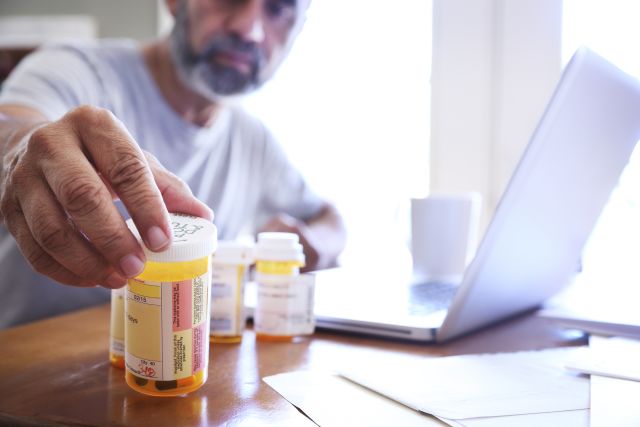Updated on October 21, 2024.
Managing bipolar disorder is a balancing act—and it can be hard sometimes. The trick is to smooth out the highs and lows and treat the flare-ups of depression or mania without tipping too far in either direction. And because the way people will react to medications can vary, treatment can often be a trial-and-error process.
The result, research shows, is that people can end up taking many prescriptions at the same time.
What is bipolar disorder?
Most of us experience shifts in mood sometimes, but for people with bipolar disorder, these fluctuations can be extreme. Bipolar disorder is a mental health condition that causes severe mood changes. Manic episodes are marked by lots of activity, irritability or excitement. Depressive episodes can cause a person’s activity level to lower, as well as feelings of indifference and hopelessness. In between these mood shifts, people with bipolar disorder will often have periods when they feel neither up nor down.
This means that treating bipolar disorder requires treating very different sets of symptoms. Mood stabilizers, antipsychotics, antidepressants and anti-anxiety medications may all be prescribed at different times to someone with bipolar disorder, and sometimes these vital and helpful medications might overlap.
How many medications are too many?
It’s not unusual for healthcare providers (HCPs) to prescribe more than one drug to manage bipolar symptoms—one to manage mood shifts, for example, and another to relieve depression or anxiety. However, some HCPs and researchers are concerned about how taking a large number of different medications, called “polypharmacy,” could affect people’s overall health.
Some HCPs are also concerned about how often treatment regimens for bipolar disorder do involve multiple drugs, and why this is the case. More drugs means more complicated and sometimes unpredictable effects. The drugs could interact with each other in negative ways, for example, and it can be hard for people to keep up with (and afford) all those medications, potentially making their treatment more complicated and less effective.
In a 2021 systematic review published in the Journal of Clinical Psychiatry, researchers looked at how often this occurs and what patterns are behind the decisions to prescribe multiple drugs. They examined the results of 49 studies and found that nearly a third of people with bipolar disorder undergoing treatment as outpatients were taking three or more bipolar-related medications, which they call “complex polypharmacy.”
The authors noted that most research on polypharmacy has only looked at the effects of taking two medications at the same time. Only a few studies have ever looked at the effects of taking a combination of more than three or more bipolar drugs at a time. And almost all studies of polypharmacy (whether 2 drugs or 3 or more) have been observational studies rather than clinical trials.
Are more meds more effective?
This means there isn’t a lot of good data out there for understanding the consequences—positive and negative—of polypharmacy for bipolar disorder. And there isn’t proof that it’s more helpful, either. Another, separate 2021 systematic review, published in the journal Acta Psychiatrica Scandinavica, asked whether prescribing multiple drugs is more effective at relieving symptoms than prescribing just one drug. The authors noted that while HCPs often assume this is true, there was no solid proof that it’s the case.
Researchers looked at 12 studies and found that there isn’t a lot of evidence to prove that more drugs makes for more effective treatment. They noted that to treat manic episodes, there was a good drug combination (lithium and valproic acid) but that there was limited evidence that a combination of drugs is more effective at treating depressive episodes.
It seems that while the practice of prescribing multiple medications at once is very common, there just isn’t enough good data yet for how advisable or effective it is.
Medication is still a vital treatment
While we’re still learning how and when to combine drugs for maximum safety and effectiveness, the fact remains that medications are the cornerstone of bipolar treatment. Because of the way bipolar affects chemicals in the brain, it’s not possible to “just cheer up” or to “just calm down.” Medications can be extremely helpful in bringing a person with a mood disorder back to a healthy and comfortable baseline.
Sometimes they can take a while to kick in. Or your body may take some time to adapt to the new medication. That’s why it’s really important to stay the course when you’ve received a new prescription, until you can consult with your HCP.
While medication is key, it’s not the only treatment. Brain stimulation treatments like electroconvulsive therapy (ECT) and transcranial magnetic stimulation (TMS) can sometimes offer relief when medications haven’t worked. Light therapy can also help with depression in the winter which many people with bipolar experience.
There are also several other approaches that can work alongside medications to help keep symptoms at bay.
Psychotherapy
Speaking to a licensed professional is a great way to help manage your bipolar disorder. Psychotherapy offers support, education, and guidance to patients and their families. People with bipolar disorder can also learn to manage day-to-day stressors that can trigger episodes and learn to change negative or harmful thoughts and behaviors.
Regular physical activity
Exercise releases chemicals in the body that promote psychological well-being. It also helps take the edge off manic and depressive episodes, combats the weight gain that’s a potential side effect of many bipolar medications and improves quality of sleep—one of the most important aspects of managing bipolar disorder.
Journaling
Having a mental health condition can lead to negative thoughts and perceived lack of control over the illness. Journaling allows you to channel depressive or manic energy into a more positive outlet. It can also help you track your mood swings, energy levels, and stress levels. By carefully noting down your feelings and the day’s events, you can also start to piece together what types of activities or events may act as triggers. Knowing your triggers can help you avoid them.
Bipolar disorder can be a challenge for the person experiencing it, but there are real and effective interventions. As you go through your treatment journey, talk with your HCP about what does and doesn’t work for you. Over time, you and your healthcare team can work toward finding treatment combinations that make the symptoms of bipolar disorder easier to manage in everyday life.







